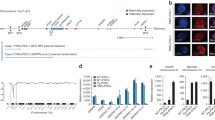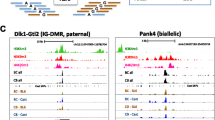Abstract
Mutations affecting a cluster of coordinately regulated imprinted genes located at 15q11-q13 underlie both Prader–Willi syndrome (PWS) and Angelman syndrome (AS). Disruption of the predominately maternally expressed UBE3A locus is sufficient to meet diagnostic criteria for AS. However, AS patients with a deletion of the entire PWS/AS locus often have more severe traits than patients with point mutations in UBE3A suggesting that other genes contribute to the syndrome. ATP10A resides 200 kb telomeric to UBE3A and is of uncertain imprinted status. An initial report indicated bialleleic expression of the murine Atp10a in all tissues, but a subsequent report suggests that Atp10a is predominantly maternally expressed in the hippocampus and olfactory bulb. To resolve this discrepancy, we investigated Atp10a allelic expression in the brain, DNA methylation status, and sensitivity to mutations of the PWS imprinting center, an element required for imprinted gene expression in the region. We report that Atp10a is biallelically expressed in both the newborn and adult brain, and Atp10a allelic expression is insensitive to deletion or mutation of the PWS imprinting center. The CpG island associated with Atp10a is hypomethylated, a result consistent with the notion that Atp10a is not an imprinted gene.






Similar content being viewed by others
References
Holm VA, Cassidy SB, Butler MG et al (1993) Prader–Willi syndrome: consensus diagnostic criteria. Pediatrics 91:398–402
Williams CA, Frias JL, Opitz JM (1982) The Angelman (“happy puppet”) syndrome. Am J Med Genet 11:453–460
Kishino T, Lalande M, Wagstaff J (1997) UBE3A/E6-AP mutations cause Angelman syndrome. Nat Genet 15:70–73. doi:10.1038/ng0197-70
Matsuura T, Sutcliffe JS, Fang P et al (1997) De novo truncating mutations in E6-AP ubiquitin-protein ligase gene (UBE3A) in Angelman syndrome. Nat Genet 15:74–77. doi:10.1038/ng0197-74
Lossie AC, Whitney MM, Amidon D et al (2001) Distinct phenotypes distinguish the molecular classes of Angelman syndrome. J Med Genet 38:834–845
Herzing LB, Kim SJ, Cook EH Jr, Ledbetter DH (2001) The human aminophospholipid-transporting ATPase gene ATP10C maps adjacent to UBE3A and exhibits similar imprinted expression. Am J Hum Genet 68:1501–1505. doi:S0002-9297(07)61061-1 [pii]
Meguro M, Kashiwagi A, Mitsuya K et al (2001) A novel maternally expressed gene, ATP10C, encodes a putative aminophospholipid translocase associated with Angelman syndrome. Nat Genet 28:19–20. doi:10.1038/8820988209 [pii]
Hogart A, Patzel KA, LaSalle JM (2008) Gender influences monoallelic expression of ATP10A in human brain. Hum Genet 124:235–242. doi:10.1007/s00439-008-0546-0
Cook EH Jr, Lindgren V, Leventhal BL et al (1997) Autism or atypical autism in maternally but not paternally derived proximal 15q duplication. Am J Hum Genet 60:928–934
Dhar MS, Webb LS, Smith L, Hauser L, Johnson D, West DB (2000) A novel ATPase on mouse chromosome 7 is a candidate gene for increased body fat. Physiol Genomics 4:93–100
Dhar MS, Sommardahl CS, Kirkland T et al (2004) Mice heterozygous for Atp10c, a putative amphipath, represent a novel model of obesity and type 2 diabetes. J Nutr 134:799–805
Kayashima T, Yamasaki K, Joh K et al (2003) Atp10a, the mouse ortholog of the human imprinted ATP10A gene, escapes genomic imprinting. Genomics 81:644–647. doi:S0888754303000776 [pii]
Kashiwagi A, Meguro M, Hoshiya H et al (2003) Predominant maternal expression of the mouse Atp10c in hippocampus and olfactory bulb. J Hum Genet 48:194–198. doi:10.1007/s10038-003-0009-3
Kayashima T, Ohta T, Niikawa N, Kishino T (2003) On the conflicting reports of imprinting status of mouse ATP10a in the adult brain: strain-background-dependent imprinting? J Hum Genet 48:492–493. doi:10.1007/s10038-003-0061-z Author reply 494
Brannan CI, Bartolomei MS (1999) Mechanisms of genomic imprinting. Curr Opin Genet Dev 9:164–170. doi:S0959-437X(99)80025-2 [pii] 10.1016/S0959-437X(99)80025-2
Ohta T, Gray TA, Rogan PK et al (1999) Imprinting-mutation mechanisms in Prader–Willi syndrome. Am J Hum Genet 64:397–413. doi:S0002-9297(07)61746-7 [pii] 10.1086/302233
Farber C, Dittrich B, Buiting K, Horsthemke B (1999) The chromosome 15 imprinting centre (IC) region has undergone multiple duplication events and contains an upstream exon of SNRPN that is deleted in all Angelman syndrome patients with an IC microdeletion. Hum Mol Genet 8:337–343. doi:ddc040 [pii]
Yang T, Adamson TE, Resnick JL et al (1998) A mouse model for Prader–Willi syndrome imprinting-centre mutations. Nat Genet 19:25–31. doi:10.1038/ng0598-25
Johnstone KA, DuBose AJ, Futtner CR et al (2006) A human imprinting centre demonstrates conserved acquisition but diverged maintenance of imprinting in a mouse model for Angelman syndrome imprinting defects. Hum Mol Genet 15:393–404. doi:ddi456 [pii] 10.1093/hmg/ddi456
Chamberlain SJ, Brannan CI (2001) The Prader–Willi syndrome imprinting center activates the paternally expressed murine Ube3a antisense transcript but represses paternal Ube3a. Genomics 73:316–322. doi:10.1006/geno.2001.6543S0888-7543(01)96543-7 [pii]
Clark SJ, Harrison J, Paul CL, Frommer M (1994) High sensitivity mapping of methylated cytosines. Nucl. Acids Res 22:2990–2997. doi:10.1093/nar/22.15.2990
Albrecht U, Sutcliffe JS, Cattanach BM et al (1997) Imprinted expression of the murine Angelman syndrome gene, Ube3a, in hippocampal and Purkinje neurons. Nat Genet 17:75–78. doi:10.1038/ng0997-75
Rougeulle C, Cardoso C, Fontes M, Colleaux L, Lalande M (1998) An imprinted antisense RNA overlaps UBE3A and a second maternally expressed transcript. Nat Genet 19:15–16. doi:10.1038/ng0598-15
Peery EG, Elmore MD, Resnick JL, Brannan CI, Johnstone KA (2007) A targeted deletion upstream of Snrpn does not result in an imprinting defect. Mamm Genome 18:255–262. doi:10.1007/s00335-007-9019-3
Landers M, Calciano MA, Colosi D et al (2005) Maternal disruption of Ube3a leads to increased expression of Ube3a-ATS in trans. Nucleic Acids Res 33:3976–3984. doi:33/13/3976 [pii] 10.1093/nar/gki705
Acknowledgments
We are grateful to Darragh Devine and K. Amy Chen for their help in conducting the brain dissection technique. This work was funded by National Institutes of Health grant HD037872.
Author information
Authors and Affiliations
Corresponding author
Rights and permissions
About this article
Cite this article
DuBose, A.J., Johnstone, K.A., Smith, E.Y. et al. Atp10a, a gene adjacent to the PWS/AS gene cluster, is not imprinted in mouse and is insensitive to the PWS-IC. Neurogenetics 11, 145–151 (2010). https://doi.org/10.1007/s10048-009-0226-9
Received:
Accepted:
Published:
Issue Date:
DOI: https://doi.org/10.1007/s10048-009-0226-9




